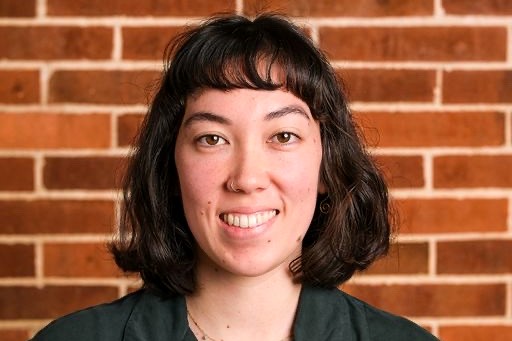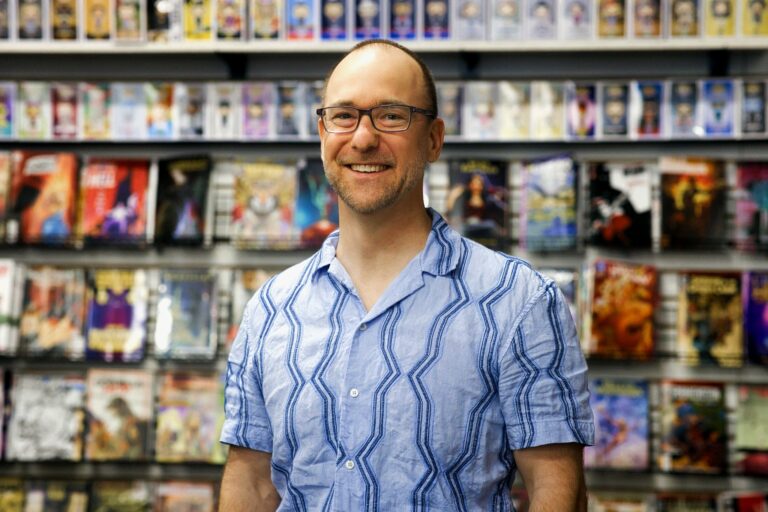Few television shows have left as indelible a mark on popular culture as The Simpsons, which is the longest running animated series, longest running sitcom, and longest scripted primetime series in the history of American television.
Behind the scenes of this critically acclaimed series is a team of talented writers, artists, and animators who bring Springfield’s vibrant characters to life. Among them is Greg Checketts, a 1985 Michigan State University graduate with a B.A. in Theatre, who will celebrate 20 years with the animated series this August and who has worked on more than 200 episodes. He began his career with The Simpsons in August 2004 as a Retake Artist and now is a Lead Character Layout Artist whose dedication and creativity have contributed to the show’s enduring success.

Checketts will return to the Michigan State University campus this week to deliver the Spring 2024 commencement address at the College of Arts & Letters ceremony on Sunday, April 28, at the Breslin Student Events Center. His path that led him to this day is not the usual route one would take in his field, but to Checketts it makes perfect sense.
“One of the reasons people find my career interesting is that it seems unexpected,” he said. “It didn’t necessarily seem unexpected to me as I was going along. I was not a kid who wanted to be a fireman one week and a baker another week. I always knew I wanted to go into cartoons.”
Road to The Simpsons
Fueled by this love for cartoons, Checketts’ fascination with animation began at a young age. Despite this, he decided in his senior year in high school to major in Theatre at MSU, which he says is the “family university.” Both his parents and his brother had attended MSU. And he saw theatre as a concurrent interest and not a big leap to the world of animation.
“A lot of people don’t necessarily feel like their college degree matches what their future reality becomes, but I feel very lucky,” he said. “I think my college degree absolutely had something to do with my future.”

During his time at MSU, Checketts worked in the Department of Theatre’s prop shop and was involved with a couple Summer Circle Theatre seasons. After earning his degree, he worked a variety of jobs for various community theatres including scenic artist, carpenter, stage manager, and set designer. These experiences not only honed his artistic skills but also instilled in him a strong work ethic and a collaborative spirit, qualities that have served him well in the animation industry.
Checketts began to plan his move to animation in the mid-1990s at the height of the Disney Animation Renaissance, a period when Walt Disney Feature Animation produced a series of critically and commercially successful animated films.
“A lot of people don’t necessarily feel like their college degree matches what their future reality becomes, but I feel very lucky. I think my college degree absolutely had something to do with my future.”
“It was fueled by a lot of theater people making animated features at that time. So, I thought, this could be a place for me,” said Checketts, who moved to Los Angeles and began to train himself in animation by taking classes at the animation guild while working as a project coordinator for a company that made scenery for themed casinos.
Checketts eventually landed an internship at Warner Brothers and worked as a cleanup artist on various Warner Brothers films, including The Iron Giant and Osmosis Jones. Setting his sights on television, he submitted his portfolio for Futurama where it sat for over a year with no response.
“At one point, I went there and said, ‘my portfolio has been here so long it’s now out of date, and I just want to put a few new things in,’” Checketts said. “And I updated my portfolio in their lobby.”

Shortly after, Checketts was offered a test, and then a job with Futurama, a show created by Matt Groening, the creator of The Simpsons, but he had to turn the job down because he was working on something else. He later was offered the job again, which he had to turn down once more because of other work.
“I think that created a little allure that I was in demand.” Checketts said. “The next time I was unemployed I called them, and they hired me. Futurama was my first television job. I had gone from cleaning up other people’s animation drawings and getting the artwork ready for camera to Futurama where I was doing character layout and was working off my own animations for the first time.”
However, not long after Checketts was hired by Futurama, the show was canceled. He then set his sights on The Simpsons. Twice he applied for the show and was turned down both times. But he refused to give up and, with the encouragement from a friend, he applied once more and eventually landed the job.
Two Decades with The Simpsons
Checketts started working on The Simpsons during season 16 of the show, which is now in season 35 and it has been renewed for season 36.
“I don’t think there has been a person who has been hired on the show that has not thought to themselves that it is probably coming to an end soon, but at least I am getting a season or two out of it before it goes away,” Checketts said. “I thought that then and I still think that now and we are on season 35.”
As a Lead Character Layout Artist for The Simpsons, Checketts plays a pivotal role in shaping the visual style and narrative flow of each episode. His team is responsible for defining the major poses, timing, and overall design aesthetic of the characters.


“I will get the script and will get voices if they have voices and I will be assigned chunks of the show, and whatever is happening on screen it is my job to prepare it,” Checketts said. “I will set up the backgrounds, but really the main job I have is figuring out the acting for whatever character is on screen at any given scene.”
Every four to six weeks, Checketts is assigned a new episode to work on, during which time he will make about a minute and a half of animation.
“It takes a village to make a cartoon,” he said. “If you have 12 people pumping out a minute each, that’s what it takes to make an animated television show.”
“By keeping the story, emotion, and circumstances in mind while you’re drawing, rather than just the pose, my training in dramatic art has held me in good stead. I think that’s one of the reasons why I’ve lasted.”
Each episode’s premiere is worked on six to ten months in advance. Checketts recently completed work on the Halloween episode for this year and is now working on the season premiere.
“One of the things I like about working in television is that you get to work with a broad range of characters,” Checketts said. “I do like the variety and I do love working with characters like Patty and Selma, Marge’s sisters, because they are just so awful. There is something fun about drawing these characters who are doing these awful things, but I really do like drawing all of them. I feel very lucky in my life that I can spend my days getting into the psyches of cartoon characters.”

In addition to his work on The Simpsons, Checketts works on his own creative projects, including original cartoons. The creative freedom of these projects has allowed him to explore new artistic possibilities and express himself in ways that may not be possible within the confines of a long-running television series. He writes, directs, edits, does voices, and more – wearing multiple hats, like in his theatre days.
Looking back at his work in the industry, Checketts cites the combination of his theatre experience and hard work as the two major factors for his creative longevity.
“The fact that this was my second career made me feel like I had to work a little bit harder than people who started younger, or came to it more naturally,” Checketts said. “And by keeping the story, emotion, and circumstances in mind while you’re drawing, rather than just the pose, my training in dramatic art has held me in good stead. I think that’s one of the reasons why I’ve lasted.”
Advocate for the Arts
As an advocate for arts education, Checketts believes in the transformative power of creativity to enrich lives and build communities. He spent five years working as a part-time art teacher for the gifted and talented program for the Los Angeles Unified School District. Through this work and as a mentor to others, he strives to inspire the next generation of artists and storytellers.

“I believe in the education of the arts. It is something to be celebrated. It teaches collaboration. It teaches you about yourself. It teaches you about the world around you,” Checketts said. “If you know more about the world around you and you can put yourself in other people’s shoes because you’ve collaborated in the arts, then maybe people would be kinder to each other.”
Checketts also underscores the importance of recognizing and cultivating transferable skills. While many aspiring artists may focus solely on building their portfolios and resumes, Checketts believes that value lies in developing a diverse skill set that extends beyond technical proficiency. From collaboration and adaptability to critical thinking and empathy, these skills are essential for success in any profession.
“I believe in the education of the arts. It is something to be celebrated. It teaches collaboration. It teaches you about yourself. It teaches you about the world around you.”
“If you work in the arts,” Checketts said, “you pick up on so many different things, from collaboration, creating a good work ethic, thinking outside of the box, understanding of other people – those skills are transferable to all sorts of things beyond the arts, wherever you end up.”
Checketts’s journey to success has been defined by persistence, community support, and the cultivation of transferable skills. His path to The Simpsons was anything but straightforward, and he believes that the skills gained through an arts education — such as problem-solving, communication, and teamwork — are highly transferable and can benefit individuals in any field. By investing in the arts and supporting creative endeavors we can create a more inclusive and vibrant society.
“The things that you can build are the things that you do with other people and that will make for a better world,” he said. “That’s the beauty of working in the arts.”


